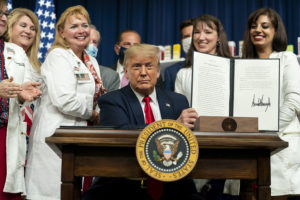
President Donald J. Trump is applauded as he displays his signature after signing Executive Orders on lowering drug prices Friday, July 24, 2020, in the South Court Auditorium in the Eisenhower Executive Office Building at the White House. (Official White House Photo by Shealah Craighead)
You have been watching as the House of Representatives, led by Speaker Nancy Pelosi and her team of radical Democrats, has stymied every attempt to help America recover from the COVID-19 recession.
President Trump has attempted to negotiate in good faith, but Pelosi is out for blood and is willing to take down the entire economy to take out Trump, no matter how many lives she ruins, businesses she bankrupts, or future generations she puts at risk.
One of President Trump’s ideas to help Americans during the hard COVID times is to stop collecting the payroll tax. Stephen Moore and Phil Kerpen lay out a plan in The Wall Street Journal on how the president can accomplish his goal despite Pelosi’s opposition. They write:
President Trump needs to reset the debate on the latest coronavirus relief bill. Senate Republicans have scuttled their best pro-growth idea—a payroll tax cut—and instead released a $1 trillion spending bill. Last week Mr. Trump acknowledged that compromising with Speaker Nancy Pelosi is a fool’s errand, because the House won’t agree to anything that boosts growth and job creation. The Democratic plan includes a six-month extension of the $600-a-week unemployment bonus and $3 trillion in new spending. It would sink the economy and imperil Mr. Trump’s re-election.
The president needs to pull an end run, and there’s a legal way to do that. He should declare a national economic emergency and announce that the Internal Revenue Service will immediately stop collecting the payroll tax. This is technically called a deferral of the tax payments.
The IRS already delayed payment of income and other taxes from April 15 until July 15. That order lays out the legal basis for a payroll tax suspension: “Section 7508A of the [Tax] Code provides the Secretary of the Treasury . . . with authority to postpone the time for performing certain acts under the internal revenue laws for a taxpayer determined by the Secretary to be affected by a Federally declared disaster. . . . Pursuant to section 7508A(a), a period of up to one year may be disregarded in determining whether the performance of certain acts is timely under the internal revenue laws.”
Mr. Trump should instruct the Treasury to stop withholding payroll taxes. To protect benefits, he should order Treasury to put bonds into the Social Security and Medicare trust funds. Since Barack Obama did that in 2011, his vice president would have a hard time explaining his opposition to it now. So would Mrs. Pelosi, who in 2011 called the tax cut “a job creator” that would give the economy “a boost.”
The catch is that under any deferral, workers would still be on the hook for paying the taxes later. Or would they?
Mr. Trump could also pledge to sign a bill—now or after the new Congress takes office on Jan. 3—to forgive those repayments. That would make the election a referendum on middle-class taxes. Mr. Trump can give Americans a tax cut now, and sign it into law later.
This bold act would flip the political tables. Democrats can’t credibly call it a tax cut for the rich. Mr. Trump could cap it at, say, $75,000 of income, so the vast majority of the benefit would go to straight into the wallets of middle- and lower-income workers, almost all of whom pay more payroll than income tax.
Voters would instantly see the 7.5% boost to their paychecks. Mr. Trump could then run against the $3 trillion House spending bill. It would be right out of the playbook of Harry S. Truman, another incumbent president who faced a big deficit in the polls and was told he couldn’t win re-election. Late in the summer of 1948, Truman stopped negotiating with what he called the “do nothing” Republican Congress and started campaigning against it. He won—and so could Mr. Trump.
The best way to help Americans is to give them back more of their money. And $600 of unemployment does nothing for the essential workers who haven’t lost their jobs but have been facing COVID-19 on the front lines every day. A payroll tax cut puts Americans back to work and lowers the burden on essential workers who need help the most.
If you are worried about how the COVID-19 response in your state could hurt your business, and you are thinking about escaping the city, sign up for my monthly Survive & Thrive newsletter.
E.J. Smith - Your Survival Guy
Latest posts by E.J. Smith - Your Survival Guy (see all)
- Rule #1: Don’t Lose Money - April 26, 2024
- How Investing in AI Speaks Volumes about You - April 26, 2024
- Microsoft Earnings Jump on AI - April 26, 2024
- Your Survival Guy Breaks Down Boxes, Do You? - April 25, 2024
- Oracle’s Vision for the Future—Larry Ellison Keynote - April 25, 2024















